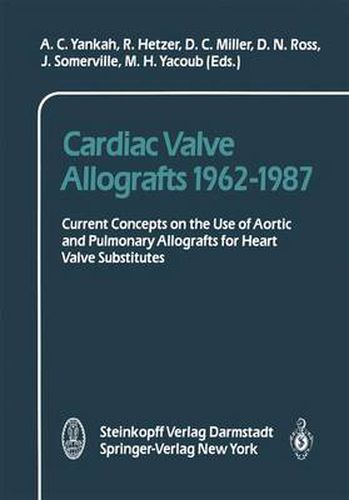Readings Newsletter
Become a Readings Member to make your shopping experience even easier.
Sign in or sign up for free!
You’re not far away from qualifying for FREE standard shipping within Australia
You’ve qualified for FREE standard shipping within Australia
The cart is loading…






This title is printed to order. This book may have been self-published. If so, we cannot guarantee the quality of the content. In the main most books will have gone through the editing process however some may not. We therefore suggest that you be aware of this before ordering this book. If in doubt check either the author or publisher’s details as we are unable to accept any returns unless they are faulty. Please contact us if you have any questions.
It was the genius of Gordon Murray in Toronto that introduced the use of allografts into cardiac surgery in the 1950s. Soon after this on opposite sides ofthe world, Sir Brian Barratt-Boyes in Auckland, New Zealand, and Mr. Donald Ross in London, undertook to use allografts for the replacement of diseased aortic valves. Since that time the global interest in allografts has been patchy, episodic, and without a con sensus. Nonetheless, for the last 20 years at least three groups in the world have steadfastly pursued the development of new and relevant information concerning the use of allograft valves in humans. These are the centres of Sir Brian Barratt Boyes, Mr. Donald Ross, and Mark O'Brien in Brisbane. More recently, talented investigators, including Drs. Yankah, Yacoub, and others, have been developing information concerning the immunological aspects of the use of allografts, as well as their clinical use. No doubt, at present, cardiac valve allografts of one sort or another are the devices of choice for conduits and have an important place in the surgery of aortic valve replacement. Even so, in the mind of this writer at least, the future usefulness of allografts for the replacement of diseased cardiac valves and conduits between a ventricle and the pulmonary artery, remains problematic, and depends upon improvements in other devices for this purpose and upon improve ments that may be made in preparing and using allografts.
$9.00 standard shipping within Australia
FREE standard shipping within Australia for orders over $100.00
Express & International shipping calculated at checkout
This title is printed to order. This book may have been self-published. If so, we cannot guarantee the quality of the content. In the main most books will have gone through the editing process however some may not. We therefore suggest that you be aware of this before ordering this book. If in doubt check either the author or publisher’s details as we are unable to accept any returns unless they are faulty. Please contact us if you have any questions.
It was the genius of Gordon Murray in Toronto that introduced the use of allografts into cardiac surgery in the 1950s. Soon after this on opposite sides ofthe world, Sir Brian Barratt-Boyes in Auckland, New Zealand, and Mr. Donald Ross in London, undertook to use allografts for the replacement of diseased aortic valves. Since that time the global interest in allografts has been patchy, episodic, and without a con sensus. Nonetheless, for the last 20 years at least three groups in the world have steadfastly pursued the development of new and relevant information concerning the use of allograft valves in humans. These are the centres of Sir Brian Barratt Boyes, Mr. Donald Ross, and Mark O'Brien in Brisbane. More recently, talented investigators, including Drs. Yankah, Yacoub, and others, have been developing information concerning the immunological aspects of the use of allografts, as well as their clinical use. No doubt, at present, cardiac valve allografts of one sort or another are the devices of choice for conduits and have an important place in the surgery of aortic valve replacement. Even so, in the mind of this writer at least, the future usefulness of allografts for the replacement of diseased cardiac valves and conduits between a ventricle and the pulmonary artery, remains problematic, and depends upon improvements in other devices for this purpose and upon improve ments that may be made in preparing and using allografts.